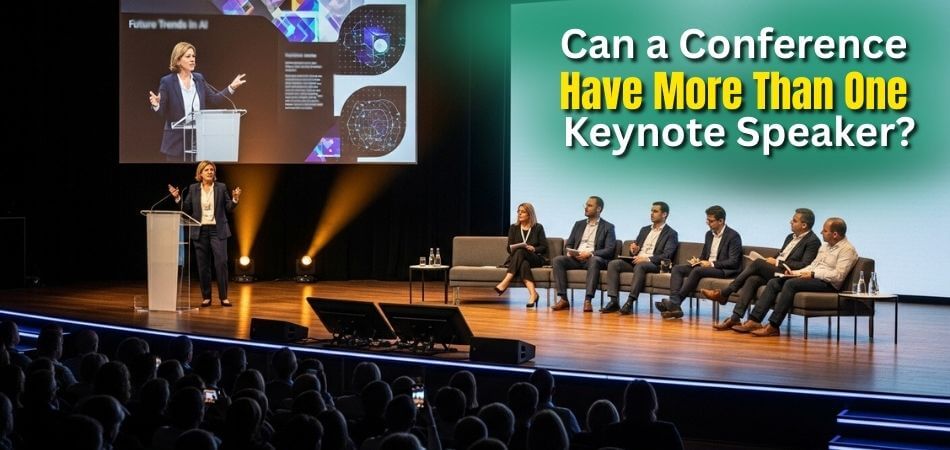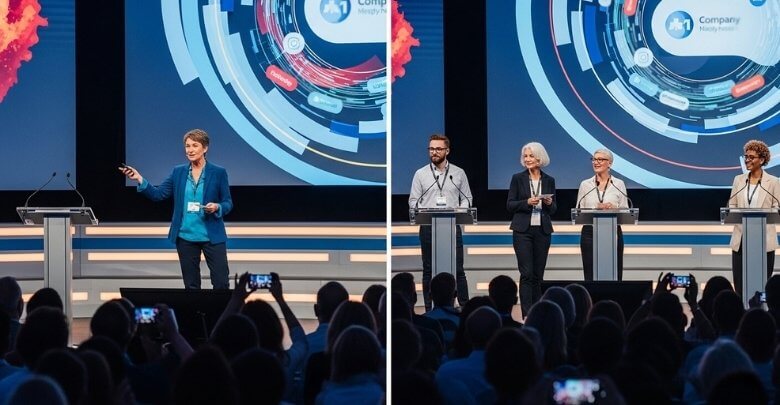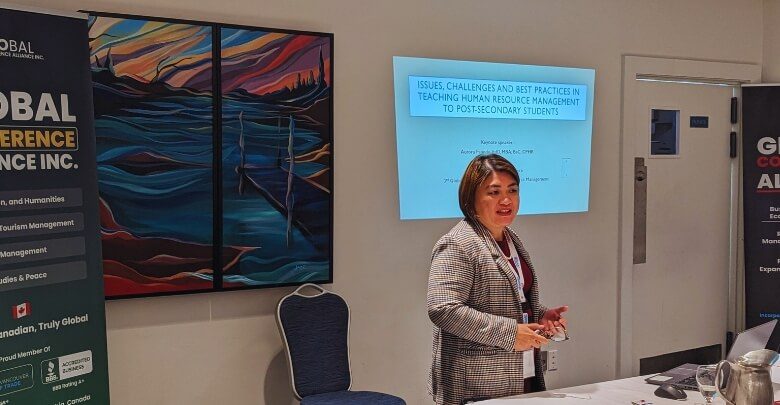Conferences bring people together to learn, share ideas, and get inspired by experts from different fields. In many cases, attendees start wondering about the role of the main speakers and may even think, Can a conference have more than one keynote speaker?
Yes, a conference can have more than one keynote speaker. Multiple keynotes add variety, cover different topics, and engage a broader audience. This approach is common at large or multi-day events to enhance value and maintain audience interest.
Do you want to know how multiple keynote speakers are chosen and scheduled, and what makes them different from other speakers? Keep reading this article to discover every important detail that will help you clearly understand the topic from start to finish.
Can a Conference Have More Than One Keynote Speaker?
When planning a conference, organizers always think about how to keep the audience engaged and inspired. One way to do this is by carefully choosing the right keynote speakers. Let’s dive into how this works in different situations.
Multiple Keynotes
A conference can absolutely have more than one keynote speaker. This is often the case when the event lasts for several days or attracts a large audience. Multiple speakers bring variety, making the sessions more engaging and keeping the overall theme fresh.
Variety of Voices
Different keynote speakers allow organizers to showcase a range of perspectives. For example, one might talk about leadership, while another focuses on innovation. Together, they provide a complete and balanced message that connects with a wider audience.
Audience Engagement
Hearing from just one voice can sometimes feel repetitive. By including more than one keynote, conferences keep participants interested and motivated throughout the event. This variety helps prevent long sessions from becoming dull or overwhelming.
Theme Coverage
Sometimes an event has a broad theme that cannot be covered by one person alone. Having multiple keynotes ensures that each important aspect of the theme gets proper attention. This way, no major point is left out during the conference.
Expert Insights
Bringing in more than one keynote allows organizers to invite specialists from different fields. Each speaker can share their own experiences and expertise, which adds depth to the event. This creates stronger value for everyone attending.
Conference Size
Smaller conferences often stick to one keynote to keep things simple. Larger gatherings, however, may benefit from several speakers, especially for international events like conferences in Canada, the USA, or any other country. Having more than one keynote in such cases helps meet the expectations of a diverse audience.
Balance and Flow
More than one keynote can help balance the program. Instead of one long talk, the sessions can be spread out over the days. This keeps the flow smooth and gives participants enough time to absorb the information.
Highlighting Diversity
When an event has speakers from different backgrounds, it reflects diversity and inclusivity. This mix of speakers shows that the conference values a range of experiences and opinions, which makes it more appealing to attendees.
Lasting Impact
Multiple keynote speakers can leave a stronger impression than just one. Attendees are more likely to remember the event when they hear a variety of stories and advice. This lasting impact makes the event more valuable and memorable.
Practical Benefits
Organizers often find it easier to share the spotlight among several speakers. If one person cannot attend, the event does not lose its main attraction. This flexibility makes planning smoother and reduces the risk of major disruptions.
Having more than one keynote speaker is not only possible but also helpful for many events. It gives the program more variety, balance, and depth. The choice depends on the goals and size of the conference.
What Are the Benefits of Having More Than One Keynote Speaker?
Event planning often revolves around keynote speakers, as they set the tone and capture attention. They set the tone and bring fresh ideas to the audience. Having more than one keynote speaker can add even more value. Let’s look at why this matters.
More Perspectives
Each speaker comes with their own experiences, skills, and style. When you bring in multiple keynote speakers, the audience gets to hear different viewpoints on the same topic. This helps people understand ideas in a wider way, instead of hearing just one angle.
Larger Audience
Not everyone is drawn to the same kind of speaker. By inviting more than one keynote speaker, you increase the chances of appealing to a bigger crowd. Some may attend to hear one speaker, while others may come for another, which grows the audience.
Diverse Topics
One speaker might focus on motivation, another on practical tips, and another on future trends. This mix makes the event richer and more useful for people. It also ensures that the event covers both big ideas and practical advice that people can use.
Engaging Discussions
When there is more than one keynote speaker, it often leads to panel talks or Q&A sessions. This creates lively discussions where ideas are compared and challenged. Audiences enjoy this because it feels natural, engaging, and often sparks fresh thinking.
Stronger Event Image
Having several keynote speakers can make the event look more professional and impactful. It shows that the organizers are serious about giving value to the audience. It also adds credibility, as people see that the event attracts top voices in the field.
Having more than one keynote speaker brings variety, draws more people, and makes the event more interesting. It creates a mix of voices and ideas that leave the audience more informed and inspired.
What Is the Difference Between a Keynote Speaker and Other Speakers?
Speakers play different roles at events, and each role has its own importance. Some are invited to set the mood, while others are chosen to share knowledge about a specific subject. To understand this better, let’s look at the differences in detail.
Role in Events
In many events, a keynote speaker is chosen not just for expertise but also for the ability to inspire and set the overall tone, while other speakers usually focus on specific subject areas. This makes the keynote stand out from the rest.
Purpose of Talk
The main goal of a keynote is to motivate and engage the audience as a whole, often touching on themes that connect to the event’s purpose. Other speakers, on the other hand, usually stick to practical topics and deliver more detailed or technical content.
Selection Process
Event organizers often pick keynote speakers based on reputation, public influence, or the ability to leave a lasting impression. Other speakers are usually selected because they have deep knowledge of a certain subject or hands-on experience that fits the event’s agenda.
Audience Impact
A keynote often brings energy and excitement, aiming to leave everyone inspired. Other speakers may not be as widely known, but they provide useful insights and details that are helpful for learning and applying in real-life situations.
Overall Contribution
Both keynote and other speakers contribute to the success of an event, but in different ways. The keynote provides the big picture and sets the tone, while the rest bring depth, details, and specific learning opportunities to the audience.
A keynote sets the stage, while other speakers build the knowledge blocks that support the event. Both roles are equally important, just with different strengths.
How Are Multiple Keynote Sessions Usually Scheduled at a Conference?
Keynote sessions are one of the main highlights at big conferences. These sessions are carefully planned so that everyone gets the chance to listen and enjoy. But the way they are scheduled can differ. Let’s look at some common styles.
Different Days
Some conferences spread keynote sessions across different days. This helps keep the audience excited throughout the event. Each day feels special with a fresh keynote speaker. It also avoids crowding too many big talks on one single day. This way, attendees can balance learning and networking.
Morning Sessions
Keynote sessions are often scheduled in the morning. This timing sets the right mood for the rest of the day. Many organizers believe people are more active and focused early in the day. It also helps create a strong opening and keeps the energy high for later sessions.
Afternoon Slots
In some conferences, keynote sessions take place in the afternoon. This timing works well if the morning is packed with workshops or smaller talks. An afternoon keynote can give everyone a break from smaller sessions. It also keeps people engaged and motivated after lunch.
Opening and Closing
Some conferences choose to have keynotes at the very start and the very end. An opening keynote sets the theme and excitement for the event. A closing keynote leaves a lasting impression. This style helps tie the whole conference together from start to finish.
Parallel Sessions
At very large conferences, keynote sessions sometimes run in parallel. This means more than one keynote happens at the same time in different halls. Attendees choose which one to join. This method gives options but may leave people wishing they could attend both.
Keynote sessions can be placed in many ways, depending on the size and style of the event. Each method has its own benefit, but the main goal is always to keep people interested and make the conference memorable.
Who Typically Gets Invited as a Keynote Speaker at Conferences?
Keynote speakers are often the highlight of most conferences. They bring knowledge, ideas, and real-life experiences that make the event memorable. Different types of professionals are often chosen to take on this role. Let’s explore who usually gets invited.
Industry Leaders
These are well-known figures in business, technology, or other professional fields. They have proven success and can share lessons from their own achievements. Their presence not only draws attention but also motivates the audience to think big and aim higher in their own work.
Academic Experts
Professors, researchers, or scholars are often chosen to speak at conferences. They provide research-based insights that add depth to the discussions. Their talks usually bring in fresh knowledge, new findings, and unique perspectives that help the audience understand topics in greater detail.
Government Officials
Leaders from government bodies are sometimes invited to speak at events. They can explain new policies, regulations, or national goals. Their presence gives the audience a chance to hear directly from decision-makers, which makes the event more credible and relevant to current issues.
High-profile Professionals
These can be authors, consultants, entrepreneurs, or top executives. They bring practical advice and real-world experiences that people can connect with. Organizers often focus on industry leaders, academics, or public figures when inviting keynote speaker candidates who can inspire and add credibility to the event.
Public Figures
Sometimes celebrities, activists, or cultural icons are chosen as keynote speakers. They may not be experts in the technical sense, but they bring attention and excitement. Their stories often connect emotionally with the audience, making the event more memorable and widely talked about.
Keynote speakers are usually chosen from respected and well-known groups like leaders, scholars, or public figures. Their presence adds credibility and ensures the event is valuable, engaging, and inspiring for everyone attending.
FAQs About Can a Conference Have More Than One Keynote Speaker?
Conferences are planned with a lot of thought, and one common question is about keynote speakers. People often wonder if more than one keynote makes sense and how it works in practice. Below are some important questions with clear answers.
Can Having Multiple Keynote Speakers Improve Learning?
Yes, having more than one keynote can improve learning. Different speakers share different ideas, which helps the audience understand topics in more than one way. This makes the sessions more complete and easier to connect with. It also helps people remember the key points better.
Do Multiple Keynote Speakers Increase Event Credibility?
Yes, they do. When a conference features several well-known speakers, it shows the event is serious and well-organized. Attendees feel that the event has more value because it brings together top voices. This makes the conference look stronger and more trusted.
Can Multiple Keynote Speakers Help With Networking?
Yes, multiple keynote speakers can encourage more networking. Each speaker may attract different groups of people with shared interests. This gives attendees a chance to connect with others they might not meet otherwise. More speakers create more variety, which opens doors for wider networking.
Are Multiple Keynote Speakers Cost-effective?
It depends on the budget and event goals. Having more than one keynote speaker may cost more, but the value they bring can outweigh the expense. A mix of speakers can attract more attendees, which may cover the costs. Organizers often see it as a smart investment.
Can Multiple Keynote Speakers Keep Energy Levels High?
Yes, they can. Listening to one person for a long time can sometimes feel tiring. With multiple speakers, the style and energy change, which keeps people fresh and engaged. This variety makes the event feel more dynamic and exciting.
Do Multiple Keynote Speakers Allow Broader Reach?
Yes, they do. Each keynote speaker has their own following or audience. When more than one is invited, the event reaches different communities. This increases the chances of attracting a larger and more diverse group of participants, both locally and internationally.
Can Multiple Keynote Speakers Handle Different Audience Interests?
Yes, multiple speakers are helpful for covering different audience interests. Some people may want motivational talks, while others may want technical insights. By having more than one keynote, the event can serve all these needs. This keeps the audience more satisfied overall.
Do Multiple Keynote Speakers Help With Branding?
Yes, they do. A lineup of strong keynote speakers can improve the image of the conference. It shows that the event can bring together respected voices. This makes it easier to promote the event and attract sponsors or partners.
Can Multiple Keynote Speakers Support International Appeal?
Yes, they can. Conferences that invite speakers from different countries often look more global. This creates interest from audiences who value worldwide perspectives. It also makes the event stand out as inclusive and open to many cultural views.
Are Multiple Keynote Speakers Good for Online Events?
Yes, they are very effective for online conferences. Virtual events sometimes struggle with audience focus, but different speakers keep things fresh. Online platforms also make it easier to include international keynote speakers. This adds value and makes the event more engaging.
Conclusion
Keynote speakers hold a special place at events, and their words often stick with people long after the sessions end. They help build the mood, set the tone, and give everyone a reason to feel excited. With the right keynote speakers, a conference becomes not just informative but also enjoyable and inspiring for everyone attending.
So, can a conference have more than one keynote speaker? Yes, it can. In fact, having more than one keynote speaker works really well, especially at larger or longer events. It brings variety, more topics, and helps keep the audience engaged. This approach adds value and makes the conference more complete.
If you’re planning a conference, try to choose keynote speakers who are engaging, trusted, and bring something unique. Mix well-known names with topic experts for better results. Most of all, enjoy the planning and good luck with making your event amazing!









